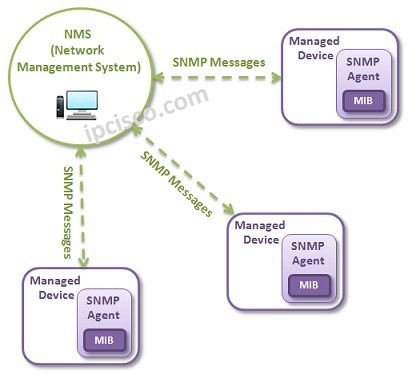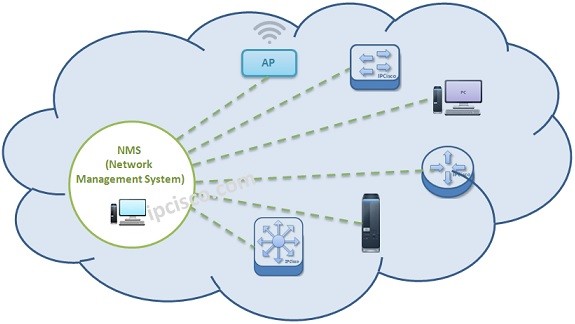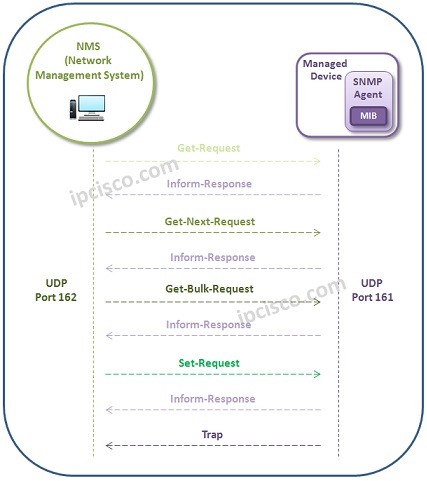- COURSES
- SPECIALS
- BLOG
- MEMBERS
- SHOP
- ABOUT
- ENROLL HERE

Simple Network Management Protocol (SNMP) is the main protocol of Network Management. With SNMP, network devices are easily managed and conttolled by a central mechanism. It is an application protocol that provide the messaging between the controlled device and the management system. In this lesson, we will focus SNMP Overview, SNMP Port, SNMP versions and more. We will also talk about SNMP Configurations, in other lessons.
Basically with SNMP, network devices are managed, their performance can be measured, any troubleshooting actions can be determined and the next level growth of the network can be easily done.
Any device in a network can be managed by Network Management Sytem with the help of SNMP. This can be a router, a switch, a PC or any other devices.

Table of Contents
Network Management via SNMP consist of some different terms. These SNMP terms are:
Firstly, we can talk about NMS. NMS is the Network Management System that manages the SNMP Operations and by doing this controls the Managed devices. The network monitoring and controling facilities is done here. This can be a dedicated device or an application on any device.
Second important term about SNMP is Managed Devices. Managed Devices are the nodes that will be managed and controlled by Network Management System (NMS).
Then, SNMP Agent is the software part of the managed device. It collects the information for the device and reports to the NMS (SNMP Manager).
Beside, MIB is the storage database for the network management information. It contains the managed device information.
we use SNMP Protocol in Network Management. It runs on IP and UDP. IT provides different message exchange during the operations. SNMP has three versions.
Lastly, SNMP Port, is the port that is used for the SNMP Communication. By default UDP Port 161 and UDP Port 162 are used as SNMP Port.
SNMP uses UDP Port 161 by default. SNMP sends and receives requests on UDP port 161. It uses also UDP Port 162 for getting SNMP TRAP⁄INFOR messages from managed devices. In other words, SNMP Manager sends commands to SNMP Agents and receives from it over UDP Port 161. If an SNMP Agent responds to the SNMP Manager with traps and information it uses UDP Port 162.
SNMP can also run over TCP (Transmission Control Protocol).
As other Network Protocols, SNMP has also some versions. For now, SNMP has three versions. These versions are :
SNMPv1 is the first SNMP version. Only requires a plain-text community string for packet authenticaiton. It has performance and security limitations.
SNMPv2c is the second and widely used SNMP version. It solves the limitation fo SNMPv1 and provide more performance. Still use community strings for authenticaion. SNMPv2 has more packet types than version 1.
SNMPv3 is the last version and it mainly concentrate on Security issue. Adds encryption and authentication mechanism to the SNMP Messages, it do not use community strings. And it has a different message format.
SNMP has different packet types in different versions. Here, mainly we will focus SNMPv2c Packets. Because it has more packets than SNMPv1 and SNMPv2c is widely used. SNMPv3 has different message types than SNMPv2c.
Mainly, there are six different SNMPv2c Packets. These packets are used in SNMPv2 Operation. Each of these packets has different duty on the Network Managemeny System Architecture. Let’s see these packets and their duties detailly.
The main six SNMPv2c Packets (or Commands) are :

get-request : It is used to request values from Agent MIB.
get-next-request : It is used to request next MIB value from Agent MIB.
inform-response : It is the response from the Agent.
set-request : It is used to set a value in Agent’s MIB.
snmpv2 trap : It is used to inform about unusual situations.
get-bulk-request : It is used to request big data from Agent MIB.
SNMP Agents send SNMP Notifications although there is no request from the SNMP Manager. There are two types notification. The first one is Traps and the second one is Inform requests.
Traps informs the SNMP Manager about the network conditions. Inform requests are also traps but they includes request for receipt confirmation. Inform requests are more reliable than traps. However, traps are often preferred because inform request consumes more memory. There is a trade-off between reliability and resources.
As you see, with traps the receipt of the notification is not know by SNMP Agent. But with inform request if the notification do not reach to the SNMP Manager, after a period of time SNMP Agent sents the inform request again. It reaches in all events but the bandwidth usage increases.
There is a table below that can show the security models and the security levels of each SNMP version.
Until now, we have talked about SNMP generally. In the following articles, we will continue with SNMP configuration examples on various vendor devices, like Cisco, Juniper, Huawei and Nokia (Alcatel-Lucent).